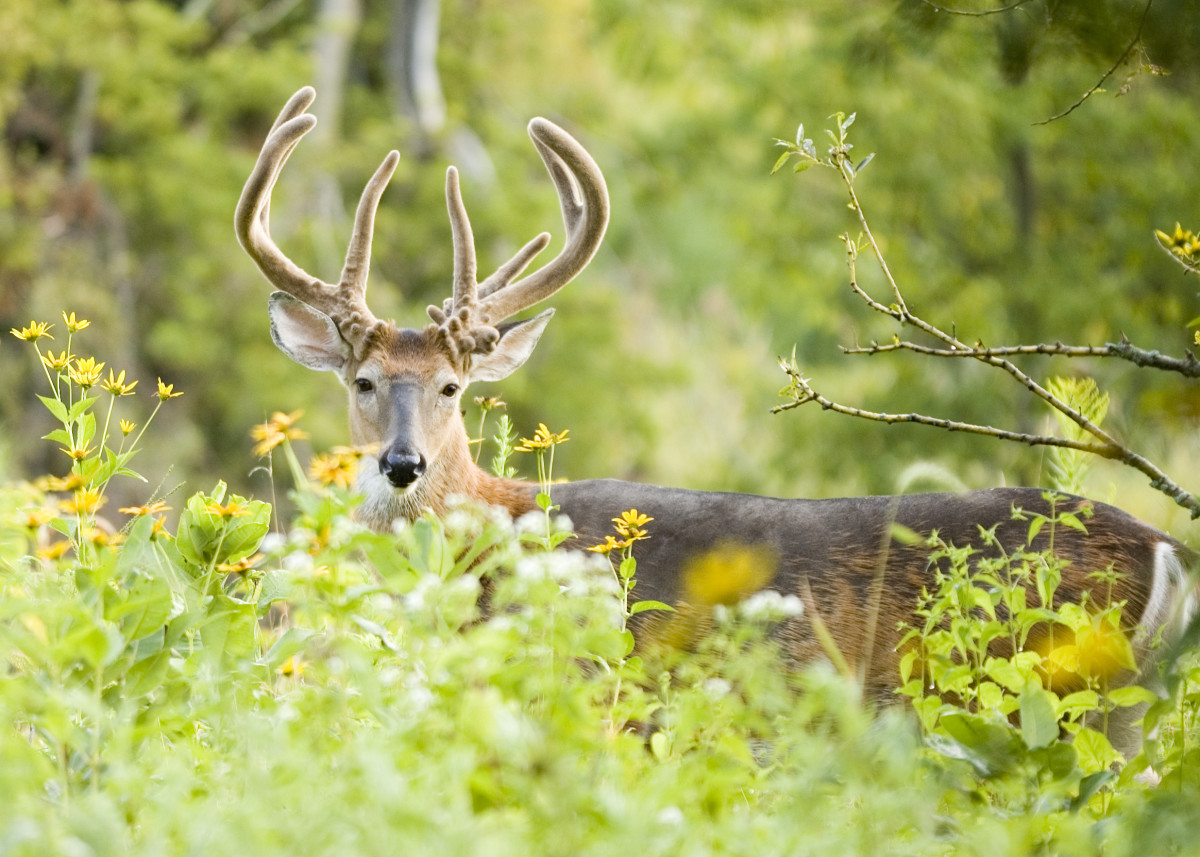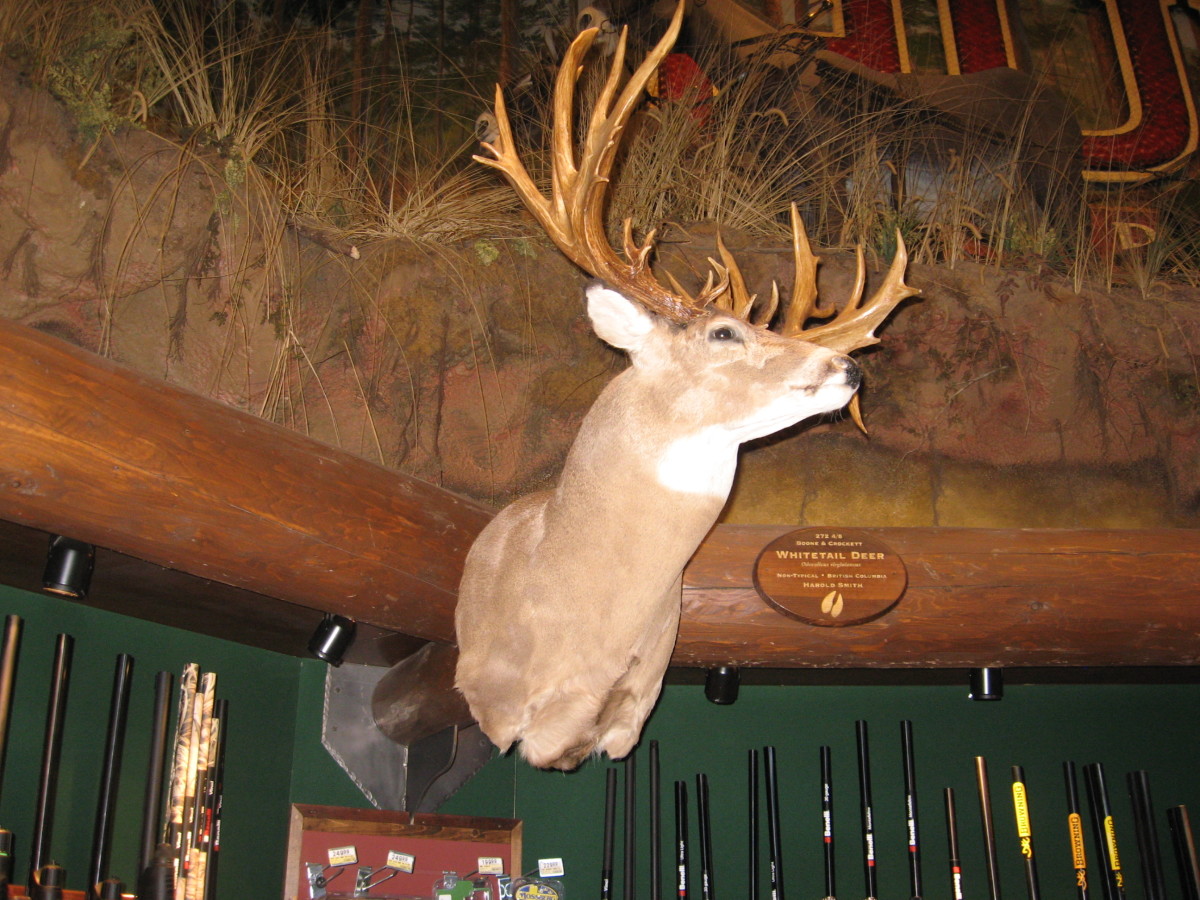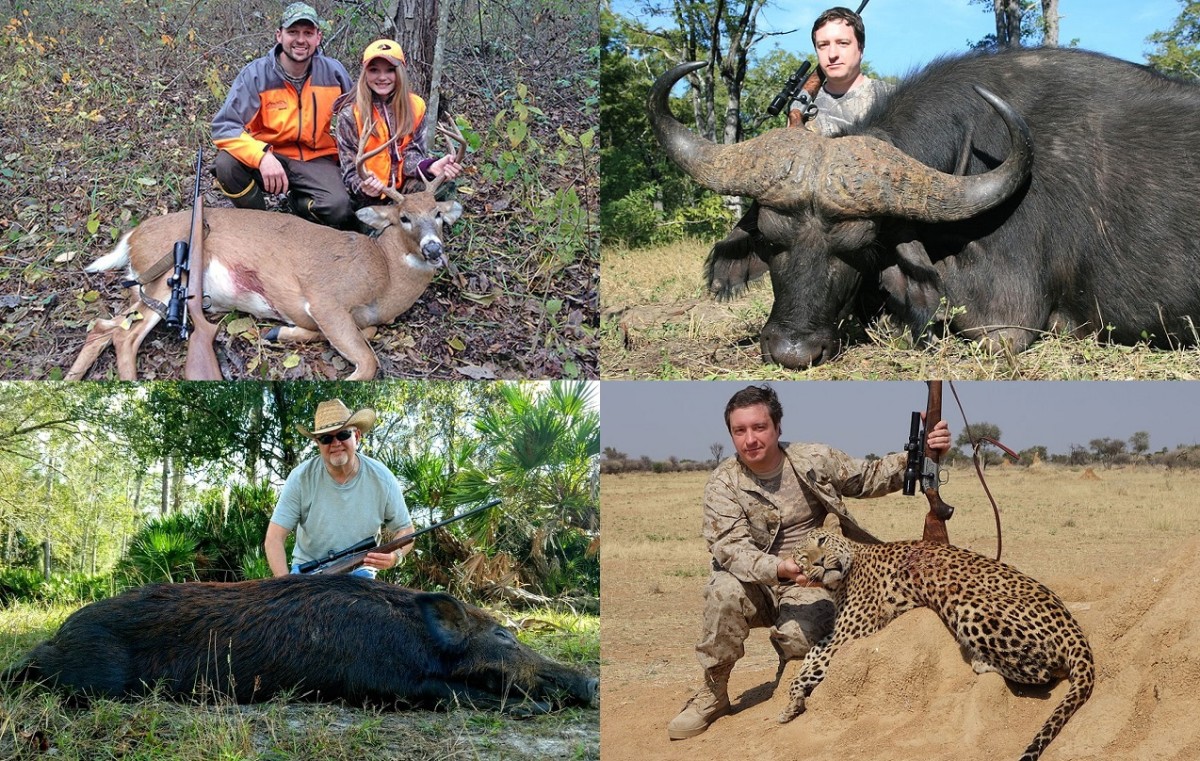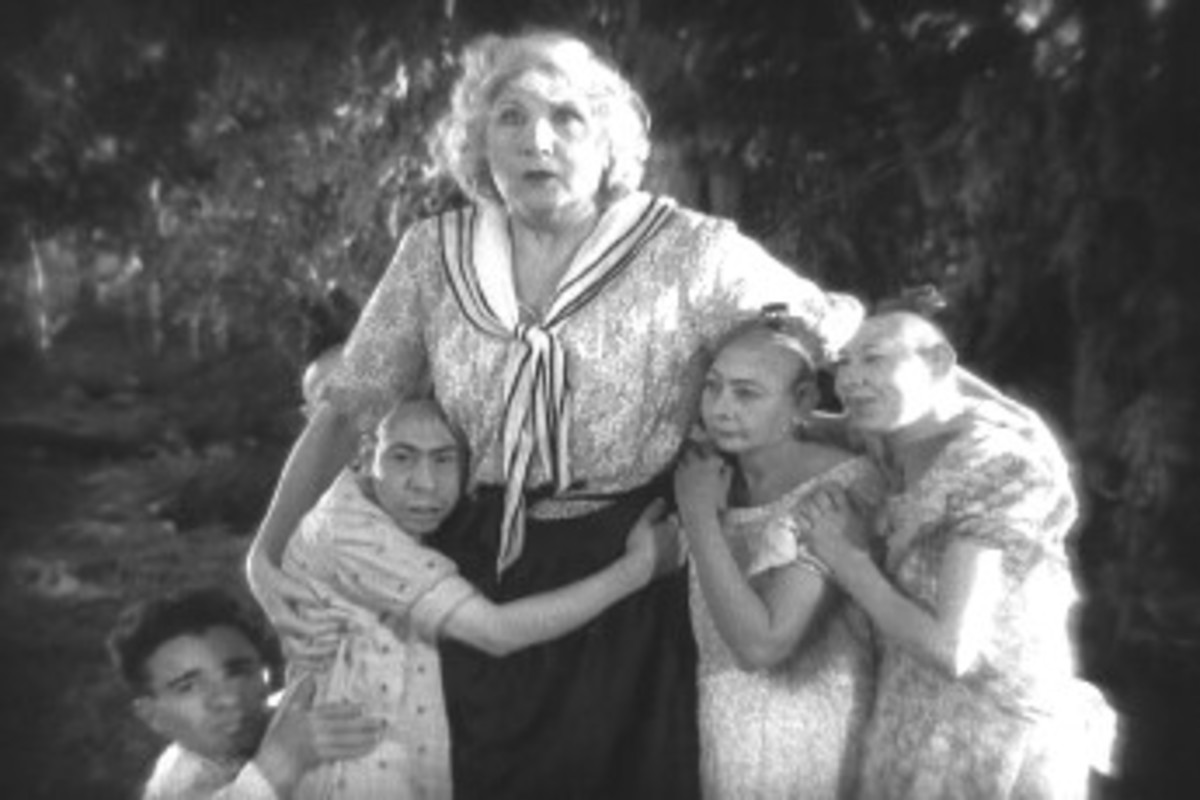Studies And Surveys Consistently Show Trophy Hunting Morally Ethically Wrong
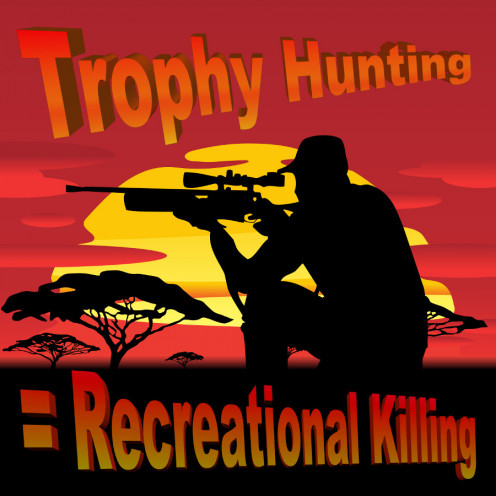
Why Call It Trophy Hunting ?
Hunters who memorialize their experiences by displaying preserved animal parts from their hunts are popularly called “trophy hunters”. Some of these hunters can object to the label, "trophy hunter", accusing their critics of focusing only on one aspect of the hunt.
When, death, however is the ultimate consequence of this one aspect of hunting, many people cannot put this one aspect aside. Death is the most serious component of life, and, therefore, it attracts great concern as to how it comes about or why. Death is life's greatest threat. Consequently, when death is part of any activity, it understandably is a primary focus. When death is a necessary component of human recreation, it becomes even more of a primary focus.
Why would any human recreation require an unavoidable component of killing? If not for food or for self defense or for eliminating some other threat to life or the greater good, then why kill? If the answer is "to be close to nature", "to socialize with friends", "to exercise", "to practice skills", or "to experience challenges and thrills", then a compassionate person cannot help but ask, "Why must killing be a necessary ingredient for satisfying any of these interests?" And if a hunter takes a body part of the dead animal as a display object to symbolize any of these activities or interests, then what else are we to call this body part, if not a "trophy"?
Why take the body part? What is this body part? What does it do? What does it say?
By definition, a trophy is a decorative object awarded as a prize for victory or success. It seems, therefore, that the hunter awards him/herself some sort of prize for victory over an animal. Or the hunter awards him/herself some sort of prize for success in achieving satisfying social experiences, effective practice of skills, physical conditioning, contact with nature, mastery of challenges, or emotional thrills.
By definition, a trophy is a souvenir of achievement. The hunter, thus, claims a souvenir for achieving a successful kill, achieving a successful encounter with nature, achieving a successful gathering of his friends, or achieving satisfaction in any other self interest.
By definition, a trophy is a memento, a keepsake, or an ornamental group of symbolic objects arranged for display. The hunter uses the animal body part for all these things – to commemorate the whole complex of fulfilling activities inescapably associated with killing.
The word, "trophy", therefore, seems to be the best adjective to modify the noun, “hunter”, in describing a person who kills animals and uses animal body parts from a kill in later displays.
Any discomfit with this label seems to indicate discomfort in how non hunters react to an activity that the label describes or, perhaps, discomfort in the hunter's realization that animal death is indeed a prerequisite interest in pursuing the recreational activity. Maybe the discomfort results from finding oneself in a position of having to admit that causing death is a necessary requirement for experiencing a fulfilling life. The discomfort is in realizing that a complex of personal satisfactions has grown around the death of another living being. The hands-on, visceral connection with death somehow consummates this complex of personal satisfactions. Discounting the death of this living being, then, might well be a way of distancing oneself from such a realization.
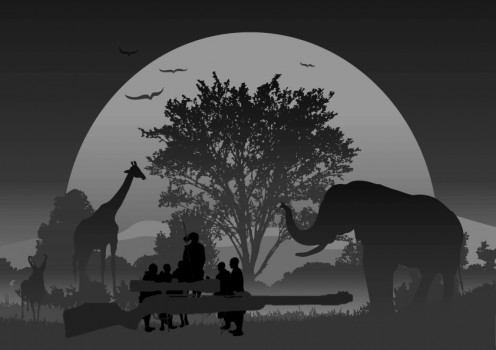
Morals And Ethics Of Trophy Hunting – Formal Studies
Life and death are sensual experiences. A person, thus, might well understand how coming into close contact with death can enhance life, since death is the canvas upon which the figures of life paint themselves. Human senses operate reflexively on such figure/ground comparisons, without the need for higher judgments to mediate them. Some of life's greatest sensual experiences take place at the edges of these figure/ground perceptions.
Human civilization, however, requires higher judgments to mediate sensual experiences, lest these pure sensual experiences cause problems for all those who must share civilization. Here is where morals, ethics, and shared values come into play.
... only those minorities sharing an ethical foundation with the public at large maintain social legitimacy.
— M. N. Peterson (2004)The following three formal studies directly relate to the morals and ethics of trophy hunting:
1. ______________________________
N. Bashqawi, (2014). ___ Kill to Conserve: Ethical Implications of Trophy Hunting Conservation Measures ___, 2014 HONORS COUNCIL OF THE ILLINOIS REGION PAPERS. PAPER 5.
This study explains how all living beings have a universal trait – a reflex to resist suffering and to resist dying. Quoting ethicist, Peter Singer [from his book, Animal Liberation], the authors point out:
“If a being suffers, there can be no moral justification for refusing to take that suffering into consideration. No matter what the nature of the being, the principle of equality requires that its suffering be counted equally with the like suffering, in so far as rough comparisons can be made, of any other being.”
They go on to point out, “One cannot claim to have the best interest of a species in mind if they cannot recognize the most basic interest in living and not suffering,” and “The so called right of a hunter to gain material satisfaction does not outweigh the suffering and death of the animal.”
They also raise an interesting question: If hunters do “respect” the animals that they kill (as many hunters claim), then what in the animals do hunters respect, if not the animals' lives and the animals' reflexes to avoid suffering? My answer is that such a claim of respect accompanying a killing is a clear contradiction at best, or worse, a lie to oneself.
The thing that defines an animal as worthy of respect is the life that infuses it with dynamic characteristics. An animal's physical presence is an embodiment of vital movements that the human mind has the curious ability to fragment into static frames. We respect a lion because of the life processes that produce its specific anatomical appearance in any one of these static frames -- its muscular form, its distinctive physical posture, or its speed within an interval between static frames of perception. Life creates these things. To say the word, “respect”, therefore, in the same breath as the word, “hunt”, says nothing about respect for these life-created characteristics. When the animal's life ends, the energy that sustains these life-created characteristics is extinguished.
What, then, can a hunter possibly respect during the act of killing the animal? My answer (again) is the hunter's own self interests in memorializing his/her sensual experiences, using a dead, highly preserved body part, now disabled from its natural process of decay in the cycle of life/death. The hunter here does NOT respect the animal – the process of the animal's life, or even the process of the animal's death. Rather, the hunter respects how the hunter sees the animal in certain static frames of individual perception, and how the hunter uses the animal corpse as a static prop in a self-serving scenario of fulfillment and achievement.
2. ______________________________
M. N. Peterson (2004). ___ An Approach For Demonstrating The Social Legitimacy Of Hunting ___. WILDLIFE SOCIETY BULLETIN, 32(2), 310-321.
Key quotes from this article are as follows:
- "Rights deemed unethical in a pluralistic democracy (e.g., polygamy, child labor, animal abuse) are deemed wrongs and receive no protection."
- "Historical acceptance of hunting is inextricably intertwined with the degree to which hunters and non hunters shared common mythical and symbolic views of hunting."
- "... only those minorities sharing an ethical foundation with the public at large maintain social legitimacy."
- "Viewing hunting as a competition where winning is dictated by physical attributes of the animal killed is morally reprehensible to most of the public."
This study points out that the shared image of hunting in existence prior to the 1960's has changed. Views of the general public attest to this fact, thereby challenging the legitimacy of trophy hunting in today's world.
3. ______________________________
L. Kalof & A. Fitzgerald (2003). ___ Reading The Trophy: Exploring The Display Of Dead Animals In Hunting Magazines ___, VISUAL STUDIES, 18(2), 112-122.
The authors of this study question the assumption that trophy displays memorialize the beauty and nature of animals, as many trophy hunters claim. Instead of memorializing nature, the authors find that photos in hunting magazines more truthfully seem to tell a different story – a story of hunting prowess, strength, virility, and tangible proof for an audience of fellow hunters about the hunters' killing experiences. Even more, the poses in trophy hunting photos convey the message of dominance and possession.
The researchers state:
- "Instead of love and respect for nature and individual animals, we found extreme objectification of animal bodies, with severed deer heads and cut-off antlers representative examples of the contradiction in the love-of-nature hunting stereotype."
- "... hunting and the exhibition of trophy animals are driven by ideologies of domination, colonialism and patriarchy.”
- "We have found that the visual representations of hunting are, to use Kheel’s word, ‘necrocentric', because death not life connects the hunter with nature and animals. In the end, the animals themselves are removed from the discourse – 'only their ghostly representations’ are visible in the form of trophy displays."
Social Acceptance Of Trophy Hunting – Formal Studies
How do these moral and ethical views actual play out in society today? Two studies point to the answer:
First ______________________________
H. Dahles (1993). ___ Game Killing And Killing Games: An Anthropologist Looking At Hunting In A Modern Society ___. SOCIETY & ANIMALS, 1(2), 169-184.
This study reports that, in the Netherlands, since the 1970's, more and more voices have demanded the abolition of hunting by law, as blood sports have come under increasing criticism in public opinion.
Second _____________________________
A. Fischer, V. Kereži, B. Arroyo, M. Mateos-Delibes, D. Tadie, A. Lowassa & K. Skogen (2013). ___ (De) Legitimising Hunting–Discourses Over The Morality Of Hunting In Europe And Eastern Africa ___. LAND USE POLICY, 32, 261-270.
These researchers report two studies showing that, over the course of twenty years, the majority of people in the USA and Sweden opposed trophy hunting.
They remind us that what establishes itself as socially legitimate are actions that most of a group agree is right and just.
They add to this their own findings for people in the six countries that they themselves studied - Ethiopia, Tanzania, Norway, Scotland, Spain, Croatia. In these additional countries, among hunters, non-hunters and hunting critics alike, hunting for trophies was often seen as an unacceptable reason to hunt, if it was the only or main one.
Furthermore, the authors state, "... south Ethiopian residents – often themselves (illegal) hunters – criticised trophy hunting for using illegal methods, such as torch lights at night, leading to the decline of wildlife populations."
Also: "Many hunting critics and non hunters argued that hunting (and especially killing) for fun could never be legitimate."
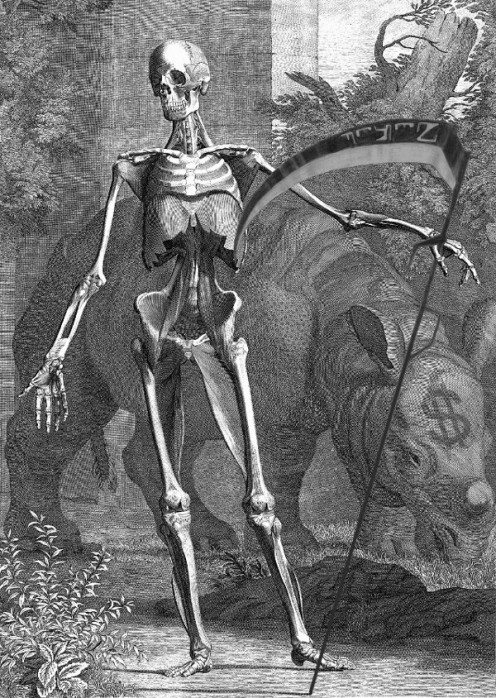
Multiple Statistical Surveys Confirm Negative Public Opinion On Trophy Hunting
1._____________________________________
2011 Synovate eNation (international market research company) survey ___ found:
- 70.4% of Americans would pay to view lions on an African safari, while only 6.6% would pay to hunt them.
eNation Survey Data
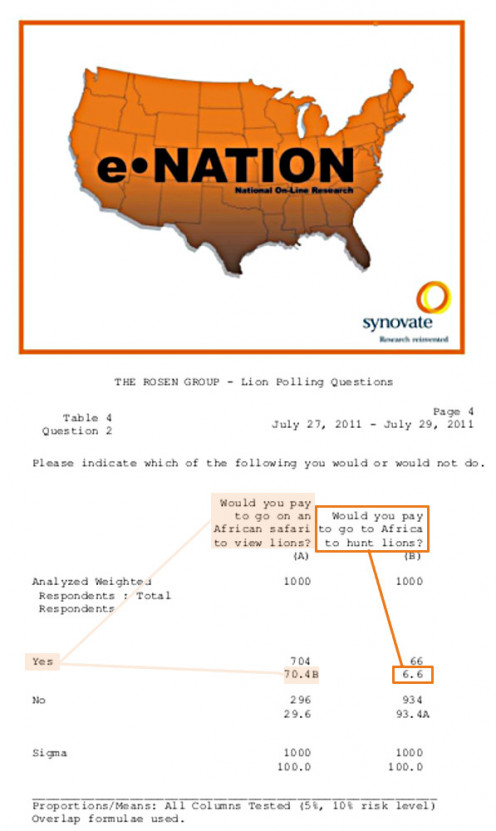
2._____________________________________
2014 survey conducted by the Beekeeper Group ___, an independent polling company, commissioned by the International Fund for Animal Welfare, found:
- The vast majority of Americans strongly oppose hunting big game.
- 80 percent of respondents opposed hunting elephants for sport.
- 79 percent opposed hunting rhinos for sport.
- 77 percent opposed hunting lions for sport.
3._____________________________________
Survey data collected in 2014 by Responsive Management ___, an internationally recognized public opinion and attitude survey research firm, showed:
- 72% of Americans disapprove of trophy hunting.
Responsive Management Survey Data
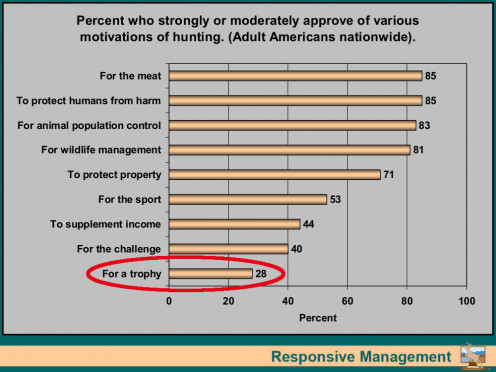
4. _____________________________________
2015 Remington Research Group survey ___, conducted on behalf of The Humane Society of the United States, found:
- Two thirds of Americans oppose trophy hunting.
- Three fourths of Americans oppose canned hunting.
- More than two thirds of the sample of respondents said that, if they could travel to Africa, then they would rather spend their tourism dollars in countries that prohibit trophy hunting rather than in countries that allow trophy hunting.
5. _____________________________________
Another 2015 Remington Research Group statewide survey ___ found:
- Florida voters strongly oppose the trophy hunting of black bears in the state, with strong majorities in every demographic group and political affiliation supporting continued protection for Florida black bears.
- Nearly two-thirds of Florida voters (61 percent) said they oppose a bear hunting season, while only 25 percent support it.
6. _____________________________________
2015 online survey conducted by Insights West ___, found:
- 91 per cent of British Columbians and 84 per cent of Albertans said they opposed hunting animals for sport.
Insights West Survey Data
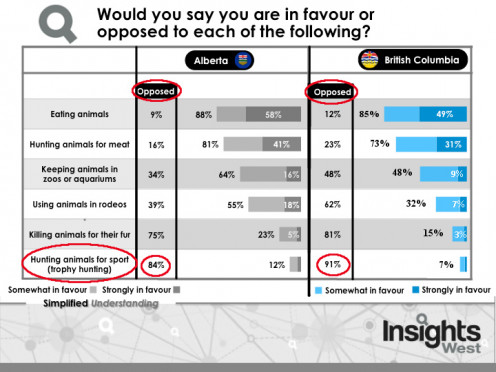
CONCLUSION
The above six surveys indicate that the prevailing attitude towards trophy hunting around the globe is negative for the current era. Even so, the practice continues, due to the efforts of a minority of hunters who claim a right based on the apparent dominance of humans over other species.
Any species that has the power to dominate other species can, of course, claim such a right. A civilization conceivably exists in the universe where living beings have technical powers that would enable them to so dominate humans. Such beings could hunt humans for recreation, claiming human body parts as trophies of the hunt. A well known series of motion pictures – the PREDATOR series – revolves around this precise theme.
I dare say that if the human race found itself under the sway of such beings, then its stance towards trophy hunting would grow to 100% against it.



